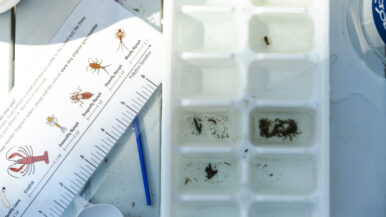Our talented team of Museum educators are committed to providing an engaging experience that brings SOL-related content to life for your students. We bring passion and energy to each program to ensure the highest level of impact and retention. To learn more about this program, click on one of the format options listed below.
Choose your experience:
Duration: 1 hour 15 minutes
Climate change is affecting every aspect of the environment, from warming waters, to shifts in species ranges. With the Chesapeake Bay as one of the most rapidly-changing areas when it comes to climate change, we have the responsibility to take action! In this program, students will learn some of the problems affecting the Bay and its wildlife and discover ways to get involved in the fight against climate change.
Duration: 1 hour 15 minutes
Climate change is affecting every aspect of the environment, from warming waters, to shifts in species ranges. With the Chesapeake Bay as one of the most rapidly-changing areas when it comes to climate change, we have the responsibility to take action! In this program, students will learn some of the problems affecting the Bay and its wildlife and discover ways to get involved in the fight against climate change.
Learning Objectives
Students will:
- Better understand the difference between weather and climate and how climate change works,
- Identify the numerous ways that climate change is affecting the Chesapeake Bay, and
- Discover that changes to plants and animals within the Bay have already been observed and continue.
Science (VDOE 2018):
- Elementary: 4.1 (a,e,h,), 4.5 (f), 4.9, 5.1 (a,c,d,f)
- Middle: 6.1 (a,c,d,f), 6.6 (d,e), 6.8, 6.9
- High: LS.1 (a,c), LS.7, LS.8, LS.9
Next Generation Science Standards:
- Elementary: 3-ESS3-1, 4-ESS3-1,
- Middle: MS-ESS3-3, MS-ESS3-5
Principles of Ocean Literacy:
- 6) The ocean and humans are inextricably interconnected
Pricing:
Payment can be made before the program, or we can invoice following your program.
- Programs at the Museum are $4.50 per student.
All adults accompanying a field trip are free. - Programs at your location are $4.50 per student.
- Virtual education programs are $125 per program.
Reservations are required for all programs and are booked on a first-come, first-served basis. Programs fill quickly in the fall and spring, so make your reservations a minimum of two weeks in advance.
Need some questions answered?
Our team is happy to answer any questions you may have, or recommend the best program for your class.
Call or email our Education team:
[email protected]
(757) 591-7745





